How to remove ads and pop-ups delivered by the gloyah.net website
Notification SpamAlso Known As: gloyah.net pop-up
Get free scan and check if your device is infected.
Remove it nowTo use full-featured product, you have to purchase a license for Combo Cleaner. Seven days free trial available. Combo Cleaner is owned and operated by RCS LT, the parent company of PCRisk.com.
What is gloyah[.]net?
gloyah[.]net is related to adf.ly, a legitimate website that provides a URL-shortening service. The users of this service are paid for shortening URLs and promoting them, since each visitor is presented with a five-second advertisement before the target (website) is reached. Note that gloyah[.]net is one of the websites promoted by adf.ly
![gloyah[.]net pop-up redirects](/images/stories/screenshots201905/gloyahnet-homepage.jpg)
Users who visit gloyah[.]net are asked to enable browser notifications. Once permission is granted, they will start to encounter "push notifications" (small pop-ups) delivered by various other sites. At time of research, one of the sites promoted by gloyah[.]net included rightorsidsorew[.]pro, however, this is not the only URL promoted.
Be aware that clicking these browser notifications is very risky, since they can lead to a number of dubious websites that promote potentially unwanted applications (PUAs) and they record sensitive data. PUAs typically offer "useful features", however, they simply cause redirects, gather information, and deliver advertisements.
Therefore, visiting websites promoted through browser notifications might lead to system infections and serious privacy issues. If you have already visited the gloyah[.]net website and enabled browser notifications, follow the instructions below. We also recommend that you check the list of installed applications/browser plug-ins and uninstall all suspicious entries.
| Name | gloyah.net pop-up |
| Threat Type | Push notifications ads, Unwanted ads, Pop-up ads |
| Serving IP Address | 172.64.170.19 |
| Related Domains | rightorsidsorew[.]pro |
| Symptoms | Seeing advertisements not originating from the sites you are browsing. Intrusive pop-up ads. Decreased Internet browsing speed. |
| Distribution Methods | Deceptive pop-up ads, potentially unwanted applications (adware) |
| Damage | Decreased computer performance, browser tracking - privacy issues, possible additional malware infections. |
| Malware Removal (Windows) |
To eliminate possible malware infections, scan your computer with legitimate antivirus software. Our security researchers recommend using Combo Cleaner. Download Combo CleanerTo use full-featured product, you have to purchase a license for Combo Cleaner. 7 days free trial available. Combo Cleaner is owned and operated by RCS LT, the parent company of PCRisk.com. |
There are hundreds of potentially unwanted applications (PUAs), all of which are very similar. As mentioned above, these programs offer "useful features", but usually have just one purpose: to generate revenue for the developers.
Rather than giving any value for regular users, PUAs cause redirects (thereby promoting dubious sites, most of which are fake search engines), deliver advertisements (which also redirect to dubious sites and might even run scripts that download/install unwanted software), and gather sensitive data.
By performing these actions, PUAs significantly diminish the browsing experience and pose a significant threat to your privacy/computer safety.
How did adware install on my computer?
PUAs usually infiltrate computers without users' consent. As mentioned above, they are often distributed using intrusive advertisements, however, these programs are also proliferated using a deceptive marketing method called "bundling" - stealth installation of third party applications together with regular software.
Developers hide "bundled" programs behind "Custom/Advanced" options or other sections of the download/installation processes. Furthermore, many users often rush download/installation processes and skip steps.
Additionally, they click advertisements without understanding the possible consequences. This behavior can lead to inadvertent installation of third party programs.
How to avoid installation of potentially unwanted applications?
To system infiltration by PUAs, be very cautious when browsing the Internet and downloading/installing software. Bear in mind that intrusive advertisements usually seem legitimate. Once clicked, however, they redirect to dubious websites (gambling, adult dating, pornography, etc.). If you experience these ads/redirects, remove all suspicious applications and browser plug-ins.
Furthermore, avoid using third party downloaders/installers, since they are often monetized using the "bundling" method (developers promote PUAs). Software should be downloaded from official sources only, preferably using direct download links. Furthermore, carefully analyze each step of the download/installation processes using the "Custom" or "Advanced" settings.
Opt-out of additionally-included programs and decline offers to download/install them. The key to computer safety is caution. If your computer is already infected with rogue applications, we recommend running a scan with Combo Cleaner Antivirus for Windows to automatically eliminate them.
Appearance of gloyah[.]net website asking to enable web browser notifications (GIF):
![gloyah[.]net website appearance (GIF)](/images/stories/screenshots201905/gloyahnet-appearance.gif)
Examples of browser notifications delivered by rightorsidsorew[.]pro website:
Instant automatic malware removal:
Manual threat removal might be a lengthy and complicated process that requires advanced IT skills. Combo Cleaner is a professional automatic malware removal tool that is recommended to get rid of malware. Download it by clicking the button below:
DOWNLOAD Combo CleanerBy downloading any software listed on this website you agree to our Privacy Policy and Terms of Use. To use full-featured product, you have to purchase a license for Combo Cleaner. 7 days free trial available. Combo Cleaner is owned and operated by RCS LT, the parent company of PCRisk.com.
Quick menu:
- What is gloyah.net pop-up?
- STEP 1. Remove spam notifications from Google Chrome
- STEP 2. Remove spam notifications from Google Chrome (Android)
- STEP 3. Remove spam notifications from Mozilla Firefox
- STEP 4. Remove spam notifications from Microsoft Edge
- STEP 5. Remove spam notifications from Safari (macOS)
Disable unwanted browser notifications:
Video showing how to disable web browser notifications:
 Remove spam notifications from Google Chrome:
Remove spam notifications from Google Chrome:
Click the Menu button (three dots) on the right upper corner of the screen and select "Settings". In the opened window select "Privacy and security", then click on "Site Settings" and choose "Notifications".
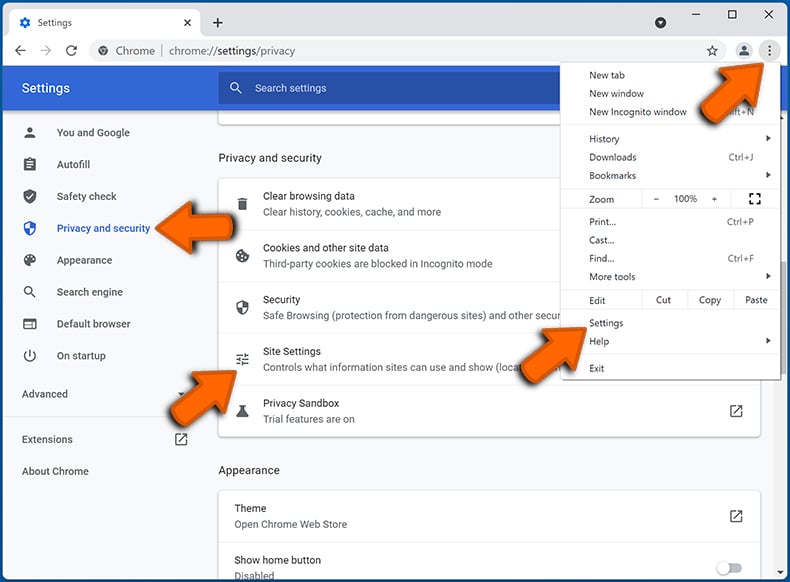
In the "Allowed to send notifications" list search for websites that you want to stop receiving notifications from. Click on the three dots icon near the website URL and click "Block" or "Remove" (if you click "Remove" and visit the malicious site once more, it will ask to enable notifications again).
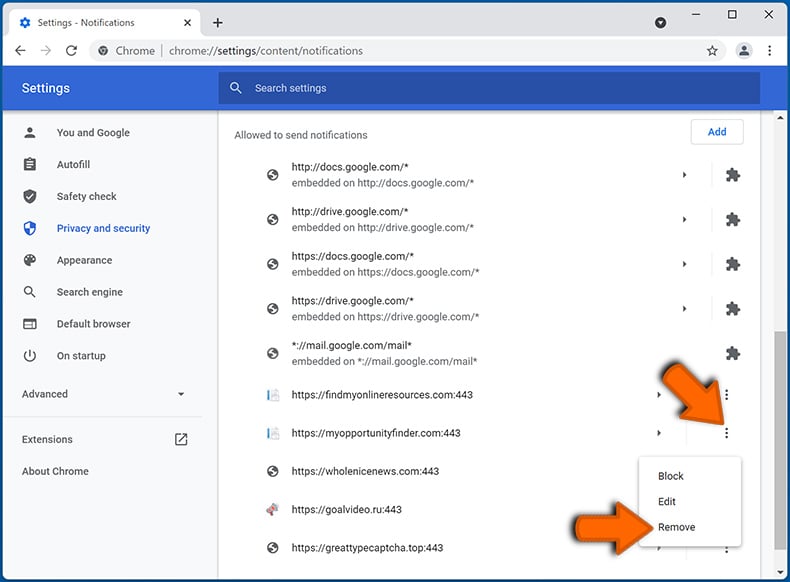
 Remove spam notifications from Google Chrome (Android):
Remove spam notifications from Google Chrome (Android):
Tap the Menu button (three dots) on the right upper corner of the screen and select "Settings". Scroll down, tap on "Site settings" and then "Notifications".
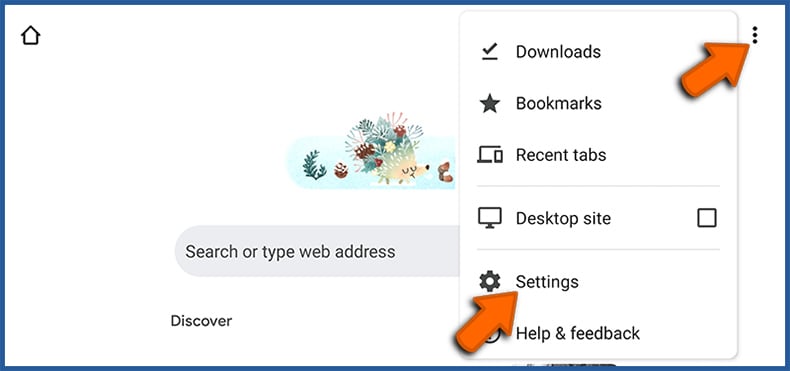
In the opened window, locate all suspicious URLs and tap on them one-by-one. Once the pop-up shows up, select either "Block" or "Remove" (if you tap "Remove" and visit the malicious site once more, it will ask to enable notifications again).
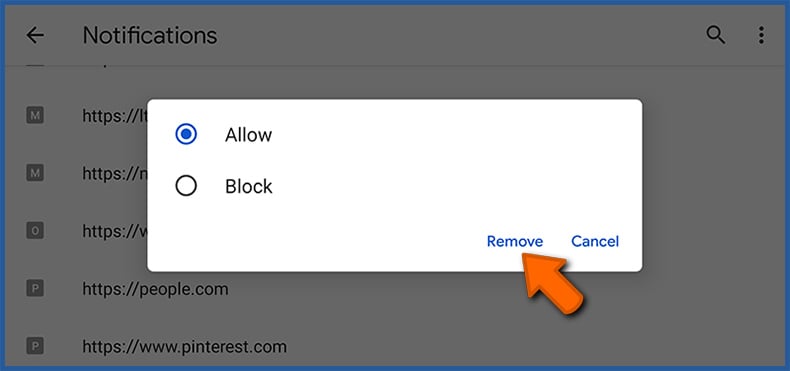
 Remove spam notifications from Mozilla Firefox:
Remove spam notifications from Mozilla Firefox:
Click the Menu button (three bars) on the right upper corner of the screen. Select "Settings" and click on "Privacy & Security" in the toolbar on the left hand side of the screen. Scroll down to the "Permissions" section and click the "Settings" button next to "Notifications".
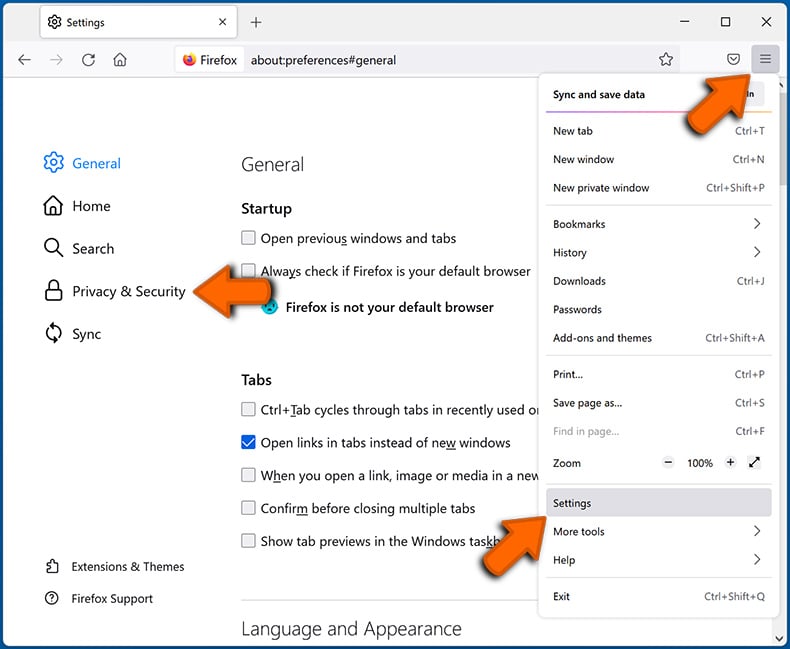
In the opened window, locate all suspicious URLs and block them using the drop-down menu or either remove them by clicking "Remove Website" at the bottom of the window (if you click "Remove Website" and visit the malicious site once more, it will ask to enable notifications again).
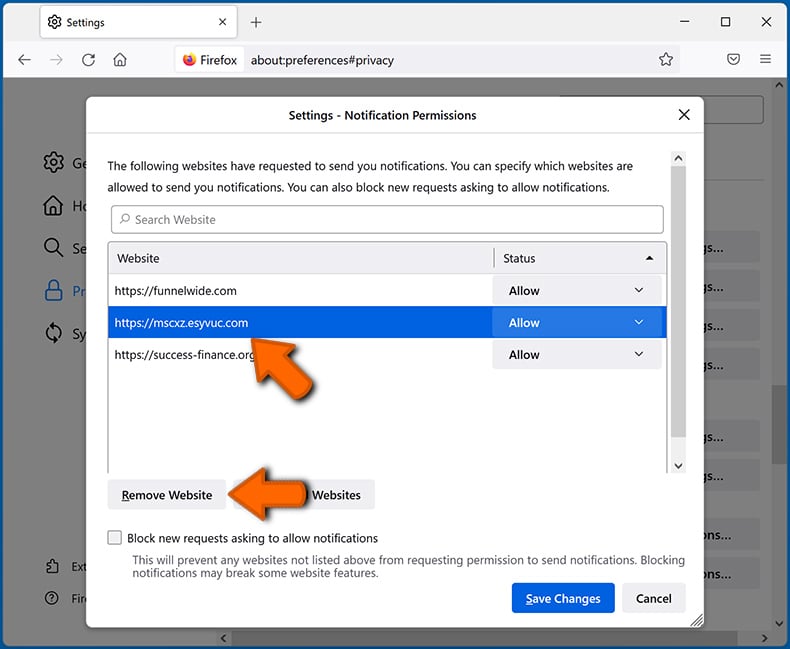
 Remove spam notifications from Microsoft Edge:
Remove spam notifications from Microsoft Edge:
Click the menu button (three dots) on the right upper corner of the Edge window and select "Settings". Click on "Cookies and site permissions" in the toolbar on the left hand side of the screen and select "Notifications".
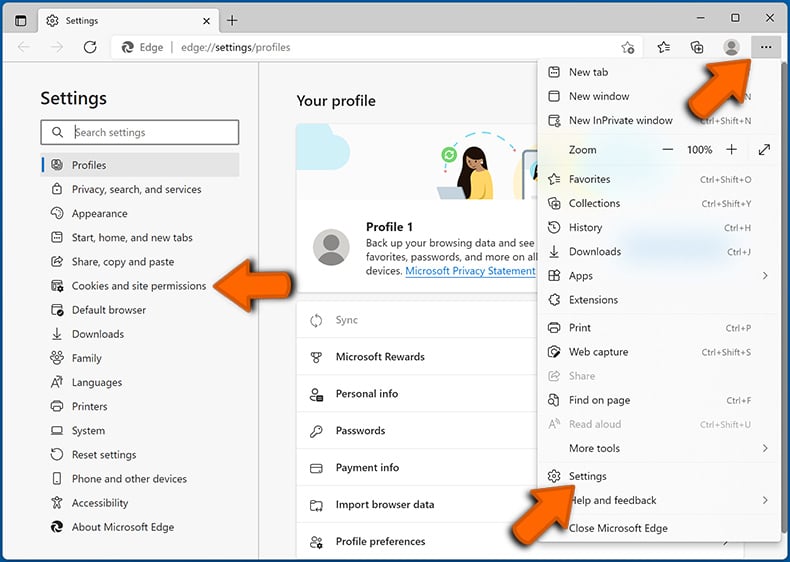
Click three dots on the right hand side of each suspicious URL under "Allow" section and click "Block" or "Remove" (if you click "Remove" and visit the malicious site once more, it will ask to enable notifications again).
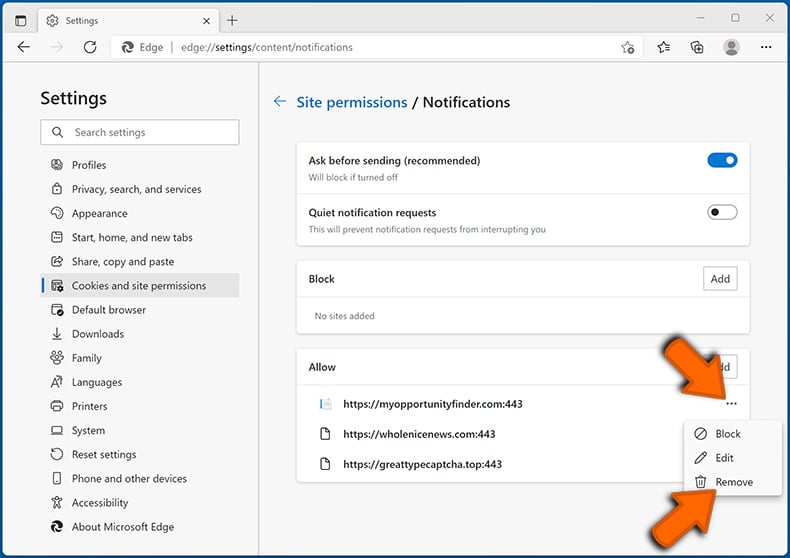
 Remove spam notifications from Safari (macOS):
Remove spam notifications from Safari (macOS):
Click "Safari" button on the left upper corner of the screen and select "Preferences...". Select the "Websites" tab and then select "Notifications" section on the left pane.
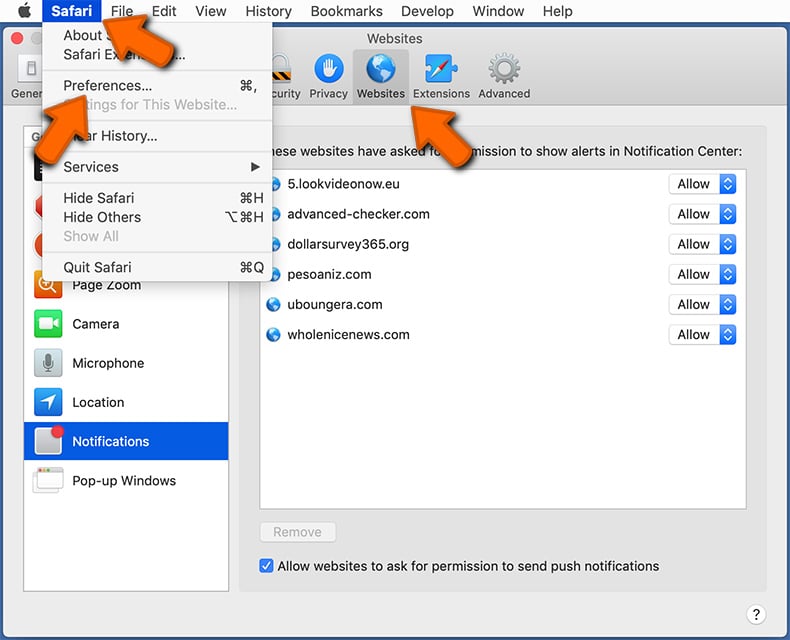
Check for suspicious URLs and apply the "Deny" option using the drop-down menu or either remove them by clicking "Remove" at the bottom of the window (if you click "Remove" and visit the malicious site once more, it will ask to enable notifications again)
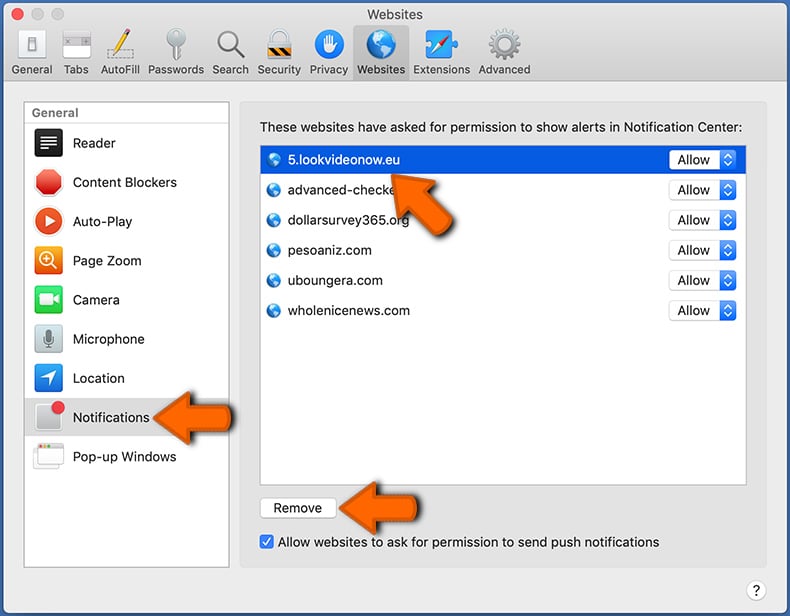
How to avoid browser notification spam?
Internet users should be very skeptical when being asked to allow notifications. While this is a useful feature that allows you to receive timely news from websites you like, deceptive marketers frequently abuse it.
Only allow notifications from websites that you fully trust. For added security - use an anti-malware application with a real-time web browsing monitor to block shady websites that tries to trick you into allowing spam notifications. We recommend using Combo Cleaner Antivirus for Windows.
Share:

Tomas Meskauskas
Expert security researcher, professional malware analyst
I am passionate about computer security and technology. I have an experience of over 10 years working in various companies related to computer technical issue solving and Internet security. I have been working as an author and editor for pcrisk.com since 2010. Follow me on Twitter and LinkedIn to stay informed about the latest online security threats.
PCrisk security portal is brought by a company RCS LT.
Joined forces of security researchers help educate computer users about the latest online security threats. More information about the company RCS LT.
Our malware removal guides are free. However, if you want to support us you can send us a donation.
DonatePCrisk security portal is brought by a company RCS LT.
Joined forces of security researchers help educate computer users about the latest online security threats. More information about the company RCS LT.
Our malware removal guides are free. However, if you want to support us you can send us a donation.
Donate
![gloyahnet-notifications2.jpg Web browser notifications by rightorsidsorew[.]pro (sample 1)](/cache/ppgallery/154360/images/stories/screenshots201905/150x150_q75_t_gloyahnet-notifications2.jpg)
![gloyahnet-notifications3.jpg Web browser notifications by rightorsidsorew[.]pro (sample 2)](/cache/ppgallery/154360/images/stories/screenshots201905/150x150_q75_t_gloyahnet-notifications3.jpg)
▼ Show Discussion